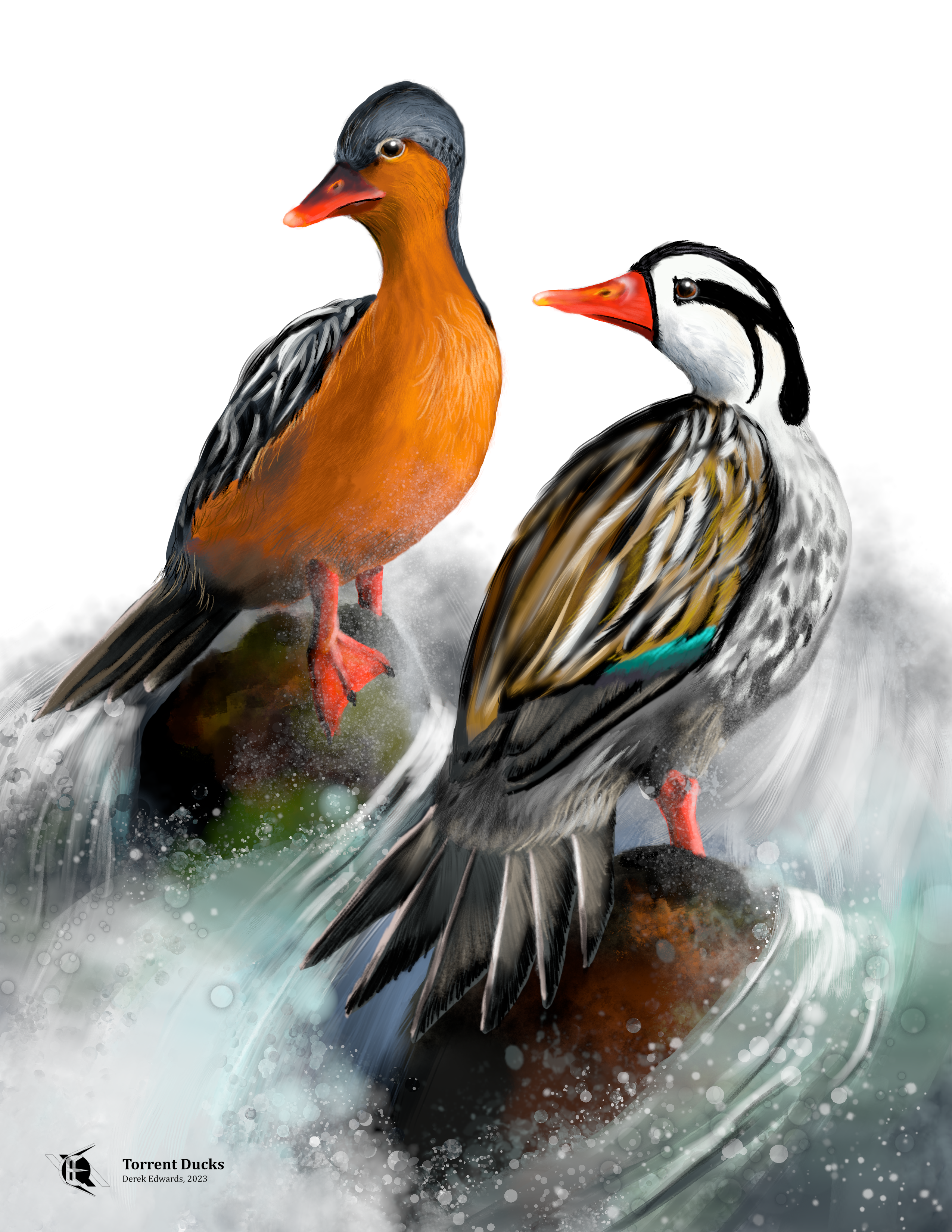
Running Commentary 11/6/2023
Hello,
Sorry to get this out a little late, especially considering that I had an extra hour to put it together. I was actually a little busy this weekend (partly drawing a double-subject bird portrait, which we'll get to later). It's November now, which means it's this newsletter's third anniversary. That I've gone three years without running out of things to write about each week is honestly quite shocking to me.
Anyway...
Watching...

Loki
- I felt likf the season finally started to pull together in this episode. Not only were the events a lot easier to follow, but the show finally remembered to be about Loki. Season 1 was all about Loki getting pulled out of the MCU story and seeing, then rejecting, his role as the always-loses villain in the heroes' journeys. Season 2 has been, so far, about needing to fix the gizmo, but now it's getting back around to being about Loki finding a new role in life. He actually had to answer why he's doing what he's doing in this episode, not just run around in a panic. Like I hoped, last episode served as a needed narrative reset.
- It was neat seeing the TVA personnel in their natural environments. I figured we'd see Mobius eventually; I also thought, as many did, that he was a Floridian, given his love of jet skis and key lime pie, but no, apparently, he's from Ohio. Actually, they all seem to be from the U.S., which I found interesting. Even Sylvie was living in Oklahoma.
- Speaking of it appears that Casey is a variant of Frank Morris, a real bank robber who escaped Alcatraz in a raft made of raincoats. (Whether he and his friends escaped San Francisco Bay is a matter of speculation.)
BattleBots
This week's episode was very much the opposite of last week's, with a roster of great bots and a bunch of great fights...at least until the final.
The rematch between Claw Viper and Hypershock was maybe the best fight of Champions II so far. Alex Bales did well driving Hypershock throughout the night; her style was less go-cart-ish-ly acrobatic than Will's, but she was more focused on some of the strategic concerns of the fights, which makes sense as she's usually the one whispering strategy in Will's ear.
The match between Hypershock and Ripperoni was rough to watch, though. I can appreciate why BattleBots changed the count out rules to allow crab-walking, but this was really the worst-case scenario for the new rules, with almost all of the three minutes spent with both bots crippled and straining to touch each other.

Maybe it's just because it's November, but the state Starchild was in at the end of its fight reminded me of the chair that Snoopy fought in A Charlie Brown Thanksgiving.


Hypershock v Starchild (via u/lilacwine2303 on Reddit) / Snoopy v Lawn Chair (via Joe Cool on YouTube)
Monsoon did pretty well. I do think they need to do more to figure self-righting out since they've gotten caught in that position that lost them the Ripperoni fight before.
So now we have our Golden Bolt Bracket. I think Ripperoni has a good chance at defeating Tantrum, but I think Endgame and Sawblaze both win their first two fights. Whiplash I think beats Jackpot. End Game I think will win a second Golden Bolt.

Bird of the Week
Imagine a duck. Likely you've imagined a mallard, but regardless, where did you imagine it? Floating in the water, reflected in its still surface? That's where most ducks can be found. In ponds, in reservoirs, in rivers, in lakes, in marshes, ducks are generally creatures of smooth waters. But that's not true of every duck, least of all the aptly named Torrent Duck.
Found in rushing streams formed from the melting caps of mountains, torrent ducks are one of the strangest and least studied of all ducks. It is possible that the species is actually several species. Torrent ducks are found throughout the Andes, an enormous mountain range reaching almost as high as the Himalayas and running almost twice as long, from the southern tip of South America up the Pacific coast almost all the way to the Isthmus of Panama. The streams formed in the Andes are the headwaters of South America's great rivers: the Orinoco, the Rio de la Plata, and the Amazon; these are among Earth's widest and flattest rivers, but they begin as a violent series of rapids and cataracts. This is where the torrent ducks live.
Determining how many species of torrent ducks truly exist was the goal of Paul A. Johnsgard, an ornithologist and professor from Nebraska, when he set out on an expedition to the Andes in 1965. He had already become a foremost expert on waterfowl by that time; the torrent ducks were the only sort he hadn't yet studied. He traveled from Colombia down through Chile, observing five different populations of torrent ducks; his conclusion was that, while different populations of torrent ducks had differing appearances, that they were all members of the same species, and that is the view still held today.1
Johnsgard described the ducks diving into the swift-flowing water from boulders in the stream, disappearing under the foam, then re-emerging some time later near where they went in. They are especially good at climbing over wet rocks, even when just hatched; they use their long, stiff tails as braces, as woodpeckers do when climbing trees. Despite living active lives at high elevations – torrent ducks are rarely found less than 5,000 feet above sea level – these birds don't eat an oxygen-efficient, high-carb diet such as that enjoyed by many lowland waterfowl. Torrent ducks feed mainly on insects, especially aquatic larvae, which they pick from between rocks using their narrow, soft-tipped bills. They get the most of this high-fat diet by having incredibly hemoglobin-rich blood; hemoglobin is an iron compound found in the blood of most vertebrates that is used to transport oxygen throughout their bodies. A 2015 expedition by researchers from the University of Miami found torrent ducks with 25 grams of hemoglobin per deciliter of blood, twice the concentration typical in humans. Torrent ducks also conserve oxygen by rarely flying; once a young torrent duck has found a mate, the pair will stay together along their chosen stretch of river for the rest of their lives. When in danger, torrent ducks have been known to dive over and then hide behind waterfalls. 1.2
While we associate "torrent" with water, it actually comes from the Latin word for "dry, parched"; the Latin word "terra", meaning "earth" or "dry land" shares the same root. Originally, a torrent was a dry riverbed prone to dangerous flash-flooding after a "torrential" rain; today, the word refers to any rushing stream, including the year-round flows of meltwater that the torrent duck lives in; by metaphor, "torrent" may also refer to the fast-flowing streams of computer data favored by content pirates.3
To science, the bird is Merganetta armata, a name given by John Gould; an ornithologist today more associated with Australian birds, Gould was one of his day's most prominent experts on South American birds, despite never having visited the continent. Gould thought that torrent ducks combined features from mergansers and diving ducks, and so gave a genus name that is a portmanteau between Mergus, the merganser genus, and Netta, a pochard genus. The species name means "armored", though what about the bird reminded Gould of armor, I don't know.5
- Johnsgard, Paul A., "Torrent Ducks of the Andes" (1972). Animals: The International Wildlife Magazine 14:2 (February 1972), pp. 80–83. Accessed via the Paul Johnsgard Collection. 31. https://digitalcommons.unl.edu/johnsgard/31
- Castillo, Jessica M. “Unique Adaptations Help Ducks Thrive in the Andes.” News@theU (2016) Last modified October 22, 2023. https://news.miami.edu/stories/2016/12/unique-adaptations-help-ducks-thrive-in-the-andes.html.
- “Definition of Torrent.” Merriam-Webster Dictionary, October 31, 2023. https://www.merriam-webster.com/dictionary/torrent.
- Gould, John. "Genus Merganetta"(1842). Proceedings of the Zoological Society of London. pt. 9, no. 106, p.96. Accessed via the Biodiversity Heritage Library. https://www.biodiversitylibrary.org/item/96442#page/107/mode/1up.
- Jobling, J. A. (editor). The Key to Scientific Names in Birds of the World (S. M. Billerman et al. editors), Cornell Laboratory of Ornithology, Ithaca.
Curation Links
Everything I Thought I Knew About Nasal Congestion Is Wrong | Sarah Zhang, The Atlantic
“Nasal congestion, I’ve learned in all this, is far weirder than I ever thought. For starters, the nose is actually two noses, which work in an alternating cycle that is somehow connected to our armpits.”
Death of an Accent | Mo Rocca, John McWhorter, & Jessica Drake, Mobituaries
[AUDIO] A look at what’s sometimes called the “Midatlantic” or “Transatlantic” accent, the New York-to-Boston, semi-British sounding manner of speaking that became the standard for proper speech in the beginning of the 20th Century before falling completely out of favor (save for Frasier) by the beginning of the 21st.
The Cincinnati Privy Disaster of 1904 | Richard O. Jones, Belt Magazine
You’ll not find a better stimulus for inappropriate laughter than this account of the collapse of an outhouse crowded with dozens of schoolgirls hiding from a sudden downpour of rain during recess. The result of negligence in upkeep in the flooring and of a design featuring an especially deep vault, the Cincinnati Privy Disaster of 1904 would claim the lives of nine children.
IRIS | Hasraf "Haz" Dulull, DUST
[FICTION] [VIDEO] "How much should we let technology control? Attack drones stop listening to commands and begin targeting all humans." (5:15
See the full archive of curations on Notion







Member Commentary